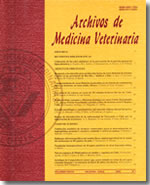Application of the EROD-H4IIE bioassay for the determination of dioxins in broiler chicken meat: an equivalence study with high resolution gas chromatography coupled to high resolution mass spectrometry
Main Article Content
Abstract
The EROD bioassay with H4IIE cell line was applied in this study to determine the equivalence of the results for chicken meat between the EROD-H4IIE Bioassay in pg TCDD-EQ/g of tissue, and the results of the gas chromatography coupled to high resolution spectrometry (HRGC/HRMS) in pg WHO-TEQ/g of fat of TEQs. 41 compound samples of chicken drumsticks were used. The samples were obtained in slaughtering plants of 4 different production facilities of Chile, during the sacrifice of animals (38 and 43 days old) between 2004 and 2007. Each sample was analysed with both analytical techniques. A regression model for the equivalence of both techniques was determined from the results. The model obtained was: HRGC/ HRMS = 0.481 + 0.051[EROD-H4IIE]2, R2 = 0.885, therefore for a value in EROD-H4IIE of 2.2 pg TCDD-EQ/g of tissue it is estimated that it will correspond to 0.73 pg WHO-TEQ/g of fat in HRGC/HRMS. Also, for the same value of EROD-H4IIE with a 95% confidence, an estimate as an upper limit equal to 0.83 pg WHO-TEQ/g of fat in HRGC/HRMS will be obtained. An upper limit equal to 0.88 pg WHO-TEQ/g of fat in HRGC/HRMS is estimated by taking the same value of EROD-H4IIE with 99% confidence. It is concluded that de EROD-H4IIE bioassay can be applied as a screening method in animal production systems and specifically in broiler chicken production.

